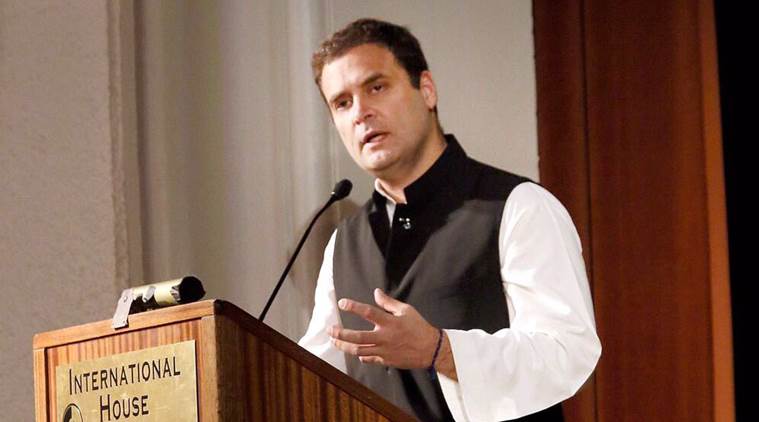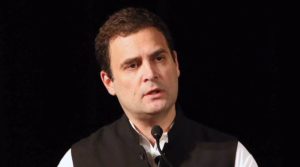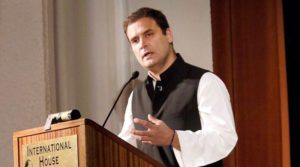Modi govt plays politics of polarisation: Rahul Gandhi’s speech at Berkeley

BY : News Gateway /Speech At Berkeley/ New Delhi /
The idea of non-violence or ahimsa, as we call it in India, is what allows this huge mass of people to rise up together. Uniting India’s religion, castes and languages would simply be impossible without it. It is this idea that Mahatma Gandhi fashioned into a powerful but beautiful political weapon.
Complete Text Of Rahul Gandhi’s Speech At Berkeley
Today happens to be the 11th of September. So I would like to start by paying homage to all the people who died on this day and all the people who lost their loved ones.
We stand with them today in their memory.
As a politician, we get to go to different places and listen to many different people. And I am going to start today by telling you a little story. Many years ago, you remember that there was a huge Tsunami, it came to India. And it hit the Andaman and Nicobar islands. And one of the things that we were doing at that time was trying to send aid to the Andaman Nicobar islands and I was looking at a list of people who had died and there are many communities who live in the Andaman Nicobar islands. And I noticed in the list that there were absolutely no tribal people who have died. So I asked some of the people there. I said, “Listen how does it happen?” I said, “There are many many people who have died. There are lots of tribals living in Andaman Nicobar but I don’t see a single tribal person who has died in the Tsunami. What happened?”

So then, one of the people there told me, you know Mr. Gandhi when the Tsunami comes, the sea goes out. And when the sea goes out, huge numbers of fish are left stranded. And he said, the tribals, they know when a tsunami goes out and when a tsunami comes in, whereas the non-tribals did not know this. And when the Tsunami came, the sea went out.
All the non-tribals ran to get the fish and all the tribals ran into the hills. And some of the tribals told the non-tribals, don’t go there. You are going to get killed. They didn’t listen. They ran into the sea. And that’s why no tribals died.
And as a liberal today, that’s exactly how I feel. Everybody knows that something has gone very wrong in the system. And the right-wing politicians are saying go there and pick up the fish. And people are sort of looking at the simple answers. They are looking at the simple answers but, you are not going to get results from these simple answers.
And this is one of the reasons I have come here. This is a tremendous institution but this institution believes in a liberal ideology, it believes in discussions, it believes in listening to people, it believes in conversations. And, you have a tremendous history and I respect that history. As you, Mr. Chibber said, my great grandfather came here and gave a speech. So, I would like to thank you very much for inviting me here. I am going to speak for about 15-20 minutes and then we are going to have a conversation. You can ask me all the questions you would like.
India is a massive country. It is also one of the world’s most complex countries. Every time you think you have understood India, she will reveal something new to you. In fact, I would venture to say anyone who thinks he understands India is a fool. According to most western academics and intelligence agencies in the middle of the last century, India was supposed to fail. We are 29 states covering every religion in the world. We have 17 official languages and hundreds of different dialects and a terrain that runs from the Himalayas all the way to the deserts. Most of these experts didn’t expect India to survive. Thye predicted it would fall apart, torn to pieces by its own diversity and contradictions. And yet somehow, as Indira Gandhi said, when asked whether India leans left or right, India came out standing straight and tall.
The idea of non-violence or ahimsa, as we call it in India, is what allows this huge mass of people to rise up together. Uniting India’s religion, castes and languages would simply be impossible without it. It is this idea that Mahatma Gandhi fashioned into a powerful but beautiful political weapon.
The common conception in the west is that people have ideas. You all say I have an idea. But there is an alternative way of looking at the world. The counter intuitive notion that instead of people having ideas that ideas have people. So, instead, if I have an idea, an idea has me. This notion is the basis of ahimsa or non-violence as taught by Gandhi. If one accepts the notion that ideas capture people, then the only possible response to a person infected by a bad idea, any person, is love and compassion. The only action you can take against him is to try and rid him of the bad idea and replace it with a good one. Using violence against a person who is infected by a bad idea actually results in the idea spreading more aggressively, multiplying among the people who care for him and love him. This non-violent philosophy in action has travelled far beyond India.
Non-violence is not inaction, says Cesar Chavez, it is not discussion. It is not for the timid and weak. Non-violence is hard work. It is this very idea, this beautiful struggle, that is viciously under attack in India today. But it is also the only idea on which humanity can survive the connectivity of the 21st century and come out unscathed stronger.
When Mr. Rajiv Gandhi and my dear friend Sam Pitroda who is sitting here spoke about bringing the computers to India, there were voices that ridiculed them. In fact, a leader of the BJP who became PM later asked a question: what does India need computers for? Why do we need computers, imagine that. When India built the IITs, the entire world including many in India were highly critical of the idea that a poor country should waste money on such technical institutions. They reacted to us with scepticism, wondering why a country like ours would need such institutions. Today these IITs and other higher educational institutions in India play a central role in Silicon Valley in the global progress of technology. And yet look at us today. We are rightly proud, we have done that and more lifting hundreds of millions of people out of poverty. For everything everyone says about India, there is no democratic country in human history, and I repeat that there is no democratic country in human history that has raised as many people out of poverty as India has. It is never being done. And we have not done it with violence, we have not done it by killing people, we have done it peacefully together.
For the first time in our history, India, if it is steered correctly and faithfully, have the opportunity to wipe out poverty. If India is able to lift another 350 million people out of poverty by 2030, it would be an achievement that the human race can be proud of. Doing this would require us to grow by more than over 8 percent in the next 13 years. India has done it before and can do it again. But it is imperative that India sustain a high growth rate for an uninterrupted period of 10-15 years in order to do so. At the heart of this powerful engine which India has built with its blood, sweat and bare hands since 1947 are jobs and economic growth. No amount of growth is enough for India if it’s not accompanied by the creation of jobs. It doesn’t matter how fast you grow. If you are not creating jobs, you are not actually solving the problem. So, the central challenge of India is jobs. Roughly 12 million young people, 12 million, enter the Indian job market every year. Nearly 90% of them have a high school education or less. India is a democratic country and unlike China, it has to create jobs in a democratic environment. India does not have and nor does it want China’s coercive instruments. We cannot follow their model if massive factories are controlled by fear. Jobs in India are going to come instead from small and medium scale industries. India needs to turn a colossal number of small and medium businesses into international companies. Currently, all the attention in India is paid to the top 100 companies. Everything is geared towards them. Banking systems are monopolised by them, the doors of government are always open to them and laws are shaped by them. Meanwhile, entrepreneurs running small and medium businesses struggle to get bank loans. They have no protection and no support. Yet these small and medium businesses are the bedrock of India and the world’s innovation. Big businesses can easily manage the unpredictability of India. They are protected by their deep, deep pockets and connections. But the real innovative strength of India lies with the millions of small firms and young entrepreneurs that run them. And they are relying on us to build the financial, communication and political infrastructure that would allow them to turn their skills into global businesses.

Healthcare in the 21st century is being revolutionised. Today, a doctor examines you, analyses your data and tells you what is wrong with you. All this is based on his memory. When he retires, that information is lost. Tomorrow, all the medical data is going to be digitised and accessible on computers. Two factors will determine competitiveness in healthcare. First, the type and volume of different medical processes and procedures that are taking place in a country and second, the genetic diversity of your population. India’s size will give it huge advantages. The sheer fact that India performs millions of cataract operations or heart surgeries a year, for example, means we are going to be the best at doing them. But much more important in scale will be India’s rich genetic diversity. Thousands of years of cross culturalism means that India has the world’s most genetically diverse population. If medical processes are going to be based on DNA, then India’s diversity is going to be a huge global asset. So, if you are looking at the medical processes in the 21st century, by far, the best opportunities for groundbreaking research and innovation will be in India. It is imperative that we start thinking about these systems now while addressing the critical concerns of privacy and ownership before they arise. Done properly, this can transform India’s healthcare system and while at the same time, help the world beyond our borders.
India has triggered a massive process of human transformation. The nature of India’s transformation has now reached a stage where it’s moment is so powerful that its failure is no longer an option. Our success impacts the world, but should our country fail, it will shake the entire world. What India is trying to do is to connect 1.3 billion people to the global economy with minimum disruption possible in a peaceful and compassionate way. But don’t be confused. If this process breaks down, the potential for violence is massive.
I have given you the positives. But before I end, I need to tell you what can go dangerously wrong. Our strength so far has been that we have done all this peacefully. What can destroy our momentum is the opposite energy. Hatred anger and violence and the politics of polarisation which has raised its ugly head in India today. Violence and hatred distract people from the task at hand. Liberal journalists being shot, people being lynched because they are Dalits, Muslims killed on suspicion of eating beef, this is new in India and damages India very badly. The politics of hate divides and polarises India making millions of people feel that they have no future in their own country. In today’s connected world, this is extremely dangerous. It isolates people and makes them vulnerable to radical ideas.
Finally, listening to India is very important. She will give you all the answers that you seek. India’s institutions have over 70 years have built a profound understanding of our country. We have experts in every single field. Ignoring India’s tremendous institutional knowledge and taking ad hoc decisions is reckless and dangerous. Decisions like Demonetisation which removed 86% of cash from circulation overnight and was carried out unilaterally without asking the Chief Economic Advisor, the Cabinet or even Parliament imposes a devastating cost in India.
Currently, we are not producing enough jobs. 30,000 new youngsters are joining the job market every single day and yet the Govt is only creating 500 jobs a day. And this doesn’t include the massive pool of already unemployed youngsters. The decline in economic growth today is worrying and it’s leading to an upsurge of anger in the country. The Govt’s economic policies, Demonetisation and hastily applied GST have caused tremendous damage. Millions of small businesses were simply wiped out as a result of Demonetisation. Farmers and manual labourers who use cash were hit extremely hard. Agriculture is in deep distress and farmer suicides have sky rocketed across the country. Demonetisation, a completely self-inflicted wound caused approximately 2%loss in India’s GDP. India cannot afford to grow and create jobs at the current rate. If we continue at the current rate, if India cannot give the millions of people entering the job market employment, anger will increase and it has the potential to derail what is being built so far. That will be catastrophic for India and the world beyond it. Thank you.